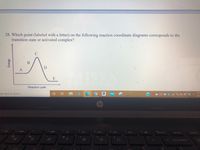
Chemistry
10th Edition
ISBN: 9781305957404
Author: Steven S. Zumdahl, Susan A. Zumdahl, Donald J. DeCoste
Publisher: Cengage Learning
expand_more
expand_more
format_list_bulleted
Question

Transcribed Image Text:28. Which point (labeled with a letter) on the following reaction coordinate diagrams corresponds to the
transition state or activated complex?
D
A
E
Reaction path
11:
pe here to search
口 *型急样行 3
2/18
hp
iort sc
delete
home
80
beckspsce
Energy
Expert Solution
arrow_forward
Answer
At State C is activated complex or transition state.
Trending nowThis is a popular solution!
Step by stepSolved in 2 steps with 1 images

Knowledge Booster
Learn more about
Need a deep-dive on the concept behind this application? Look no further. Learn more about this topic, chemistry and related others by exploring similar questions and additional content below.Similar questions
- 5 of 5 7. When a catalyst is added to a reaction the activation Energy is (increased or decreased), (more or less) energy is needed to react the new activated complex, and (more or less) collisions have sufficient energy to (increase or decrease) the reaction rate.arrow_forwardWhich one of the following statements is False? The rate constant depends on the activation energy of a reaction. A catalyst lowers the activation energy of a reaction. Rate constants are not temperature dependent.arrow_forwardQuestion 12 Which of the following best describes the rate law? O A theoretical equation that describes how the rate of reaction depends on temperature, orientation and number of collisions. O A theoretical equation that describes how the rate of reaction depends on the concentration of reactants. O An experimentally determined equation that describes how the rate of reaction depends on temperature, orientation and number of collisions. O An experimentally determined equation that describes how the rate of reaction depends on the concentration of reactants.arrow_forward
- 22. The rate of a reaction depends on many factors such as the concentration of the reactants. Which of the following explains why an increase in the concentration of reactants affects the rate of reaction? The reactants move faster. The collisions increase between the reactants. There are fewer molecules present. The activation energy is lowered.arrow_forwardAs the temperature of a reaction is increased, the rate of the reaction increases because the: a) reactant molecules collide less frequently. b) reactant molecules collide with greater energy. c) reactant molecules collide less frequently and with greater energy. d) activation energy is lowered. e) activation energy is increased because of more collisions.arrow_forwardWhich letter represents the activated complex?arrow_forward
- 22. Complex compounds that have high activation energy are complex compounds that are... A. inertB. is not stableC. stableD. labilearrow_forwardReaction rate increases with increasing concentration because of: all of the above a decrease in the activation energy of the reaction an increase in the kinetic energy of the reactant molecules an increase in the frequency of collisions between reactant moleculesarrow_forwardWhat concentration terms appear in the rate equation?arrow_forward
arrow_back_ios
arrow_forward_ios
Recommended textbooks for you
 ChemistryChemistryISBN:9781305957404Author:Steven S. Zumdahl, Susan A. Zumdahl, Donald J. DeCostePublisher:Cengage Learning
ChemistryChemistryISBN:9781305957404Author:Steven S. Zumdahl, Susan A. Zumdahl, Donald J. DeCostePublisher:Cengage Learning ChemistryChemistryISBN:9781259911156Author:Raymond Chang Dr., Jason Overby ProfessorPublisher:McGraw-Hill Education
ChemistryChemistryISBN:9781259911156Author:Raymond Chang Dr., Jason Overby ProfessorPublisher:McGraw-Hill Education Principles of Instrumental AnalysisChemistryISBN:9781305577213Author:Douglas A. Skoog, F. James Holler, Stanley R. CrouchPublisher:Cengage Learning
Principles of Instrumental AnalysisChemistryISBN:9781305577213Author:Douglas A. Skoog, F. James Holler, Stanley R. CrouchPublisher:Cengage Learning Organic ChemistryChemistryISBN:9780078021558Author:Janice Gorzynski Smith Dr.Publisher:McGraw-Hill Education
Organic ChemistryChemistryISBN:9780078021558Author:Janice Gorzynski Smith Dr.Publisher:McGraw-Hill Education Chemistry: Principles and ReactionsChemistryISBN:9781305079373Author:William L. Masterton, Cecile N. HurleyPublisher:Cengage Learning
Chemistry: Principles and ReactionsChemistryISBN:9781305079373Author:William L. Masterton, Cecile N. HurleyPublisher:Cengage Learning Elementary Principles of Chemical Processes, Bind...ChemistryISBN:9781118431221Author:Richard M. Felder, Ronald W. Rousseau, Lisa G. BullardPublisher:WILEY
Elementary Principles of Chemical Processes, Bind...ChemistryISBN:9781118431221Author:Richard M. Felder, Ronald W. Rousseau, Lisa G. BullardPublisher:WILEY

Chemistry
Chemistry
ISBN:9781305957404
Author:Steven S. Zumdahl, Susan A. Zumdahl, Donald J. DeCoste
Publisher:Cengage Learning

Chemistry
Chemistry
ISBN:9781259911156
Author:Raymond Chang Dr., Jason Overby Professor
Publisher:McGraw-Hill Education

Principles of Instrumental Analysis
Chemistry
ISBN:9781305577213
Author:Douglas A. Skoog, F. James Holler, Stanley R. Crouch
Publisher:Cengage Learning

Organic Chemistry
Chemistry
ISBN:9780078021558
Author:Janice Gorzynski Smith Dr.
Publisher:McGraw-Hill Education

Chemistry: Principles and Reactions
Chemistry
ISBN:9781305079373
Author:William L. Masterton, Cecile N. Hurley
Publisher:Cengage Learning

Elementary Principles of Chemical Processes, Bind...
Chemistry
ISBN:9781118431221
Author:Richard M. Felder, Ronald W. Rousseau, Lisa G. Bullard
Publisher:WILEY